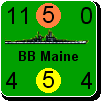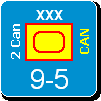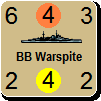Extraneous
Matrix Elite Guard

Posts: 1810
Joined: 6/14/2008
Status: offline

|
I have tidied up the write-up for Pozerica following Extraneous' quiz question. If anyone has any details about the equipment provided to the Fighter Direction Ships I would be grateful. Would like to use Tynwald for part of the Torch story.
[4701 ASW British]
.P These ASW counters are only used if playing with the Convoy In Flames optional
rule. The counters do not represent any specific individual convoy or any
particular ships, but are designed to represent convoy escort groups. They have
mixed values reflecting the fact that the make-up of an escort group could differ
from one convoy to the next. Examples of escort vessels used during the Second
World War were: escort carriers, destroyers, destroyer escorts, corvettes,
sloops, trawlers etc - in other words a wide variety of ship type was used in the
defence of merchant vessels.
.P At the start of the war the Royal Navy (RN) had too few escorts to allow it to
undertake all its required duties; protecting convoys, escorting capital ships
etc. Matters were made worse by heavy losses incurred off Norway and the Low
Countries, but gradually, the problem was resolved. A large shipbuilding program
was begun, almost from scratch, in Canada, while in the United Kingdom, priority
was given to the construction of specialised escort vessels. The Lend-Lease bill
passed in the United States further assisted the cause. As the war progressed,
the escorts available to the navies of the Commonwealth not only grew in number,
but also in effectiveness - in particular their anti-aircraft (AA) and anti-
submarine (ASW) capability.
.P There were two main threats to ocean-going convoys: Surface raiders and
U-boats, while closer to shore, aircraft and mines were a particular menace.
Unfortunately for the Kriegsmarine, the surface raiders record against Allied
convoys was ultimately to prove a disappointment. In contrast to its U-boat arm,
neither its warships nor its assortment of auxiliary cruisers came anywhere near
causing the level of destruction they had hoped for.
.P Unrestricted submarine warfare by the Germans in the First World War brought
the United Kingdom to the brink of defeat. The UK survived thanks largely to the
introduction of the convoy system, which provided the previously unguarded and
mostly unarmed merchant vessels with warship protection.
.P At the outbreak of World War II convoys were re-introduced as quickly as
possible, but there had been a lack of investment in time and resources devoted
to the subject of convoy defence during the inter-war years. This not only led to
the shortage of specialist escort vessels, but those the RN did have were fitted
with only rudimentary AA and ASW equipment.
.P Fortunately for the British, the Kriegsmarine were equally, if not more
unprepared, and actually started the war with only fifty-seven U-boats. Of
these, just twenty-six were capable of Atlantic operations. The Germans moved
quickly to rectify this deficiency via a large scale U-boat build program, and
great success was achieved in the first half of the Second World War. This led
Winston Churchill to later admit that the only thing that frightened him in World
War II was the U-boat threat. For a time the U-boats were sinking more merchant
ships than could be replaced, but in the end, the greater resources open to the
Allies; more ships and better technology, ground the U-boat menace into oblivion.
.P During the Second World War, the potency of aircraft as ship killers became
evident. Most convoy routes came under threat from air attack at some point
along their length. To reach out into the Atlantic and Arctic, the Germans
employed their long range Focke-Wulf FW200 Condor aircraft that had a range of
2,212 miles (3,560km) and a 14-hour endurance. For more confined waters like the
North Sea, the English Channel and the Mediterranean, the Axis forces were able
to employ their shorter range aircraft in the ship killer role. Ultimately, a
combination of escort carriers and stronger AA capability on board the escorts
managed to neutralise this threat too. Mines were to prove a potent weapon too,
and the Germans were very active in sowing minefields throughout the war.
Clearing paths through these obstacles was a vital role and the minesweepers of
the RN saved many a ship with their unsung work.
.P Of all the Allied convoy routes, the Atlantic was the most important. The
Battle of the Atlantic was to be the longest battle in World War II. Had the
Allies lost, the United Kingdom could have been literally starved into defeat.
It is worth remembering here that the men of the Merchant Navy suffered a higher
percentage of losses compared to the British Army, RN or Royal Air Force in World
War II, and these losses were mostly incurred in bringing food and supplies to Britain.
.P In addition, the movement of troops from the United States and the far flung
colonies and dominions of the Commonwealth to the frontline; France, India, North
Africa etc would have been much more hazardous if the Axis had control of the
sea lanes. That this did not happen is down to the bravery and sacrifice of those
that fought the enemy in all major sea areas of the world. These write-ups tell
some of those stories.
.P Note, the date on the back of these ASW and ASW Carrier counters do not relate
in any meaningful way to actual build dates for the ships that took undertook the
convoy escort role during World War II. The counter date should therefore be
ignored. In addition, the counter mix is unbalanced in terms of origin of the
escorts and those with an aircraft component. As a result there will be a degree
of RN ship write-ups on Canadian counters and carrier units being used to
describe non-Carrier counters. Finally, because these smaller ships do not have
their own counter, some of the more important non-convoy related episodes of the
war that involved these ship types, are also told within some of these write-ups.
.P These counters give information on the main types of convoy escort that were
available to the RN and the dominion navies. This write-up looks at two auxiliary
AA ships, HMS Foylebank and HMS Pozarica.
.P To better protect convoys that were vulnerable to air attack, during 1940-41,
the Admiralty converted seven merchant ships specifically for use in an AA role.
An eighth ship - the former armed merchant cruiser HMCS Prince Robert - was so
converted in 1943. The eight ships were Alynbank, Foylebank, Palomares, Pozarica,
Prince Robert, Springbank, Tynwald and Ulster Queen. These ships were given a
relatively powerful AA capability and proved useful addition to convoy defence.
Some of the ships were used extensively on the Arctic convoys to the Soviet
Union. Four of these ships were lost during the war.
.B
.B HMS Foylebank
.B Engine(s) output: ? hp
.B Top Speed: 14 knots
.B Main armament: 8 x 4-inch (102mm) guns and 8 x 2-pdr pompoms
.B Gross Registered Tons: 5,582 tons
.B Thickest Armour: n/a
.P Foylebank was built for the Bank Line in 1930. She was designed for use as a
general cargo vessel. However, by the end of that decade, she was to be used for
a very different purpose.
.P Soon after the outbreak of the Second World War, Foylebank was requisitioned
by the Admiralty for conversion into an AA auxiliary. For this role she was
fitted with eight high angle 4-inch guns as well as four twin 2-pdrs and ten 20mm
Oerlikons. Sadly HMS Foylebank - as she was now officially titled - was to have a
very short existence.
.P After the defeat of France, the English Channel became a very dangerous place
for merchant ships. Initially the British refused to give up using the Channel,
and convoys to and from the port of London were routed through this narrow
waterway rather than the much longer option of sailing via the north of Scotland.
This decision put convoys at risk of both enemy aircraft and enemy torpedo boats.
The fate of convoy OA178 reflects the seriousness of the situation in the summer
of 1940.
.P OA178 was a large convoy heading for Nova Scotia that left London on July 3, 1940.
Reconaissance aircraft spotted the fourteen-ship convoy and the next day the Luftwaffe ordered Stukas into the air to attack the vulnerable ships.
.P After hits were recorded on at least four of the merchant vessels, the order
was given to seek shelter in the port of Portland on the Dorset coast. Within the
harbour HMS Foylebank was acting as an AA guardship. Sadly, instead of being able
to provide much assistance to the convoy, Foylebank found herself a sitting duck
and was subjected to a concerted attack by German dive-bombers.
Numerous bombs hit Foylebank and she soon sank, taking 176 of her 298 crew with her.
.P One of those killed was Leading Seaman Jack Mantle. For his actions that day,
Mantle won the highest award for bravery in the face of the enemy, the Victoria
Cross. Mantle was operating the starboard pompom when Foylebank came under
attack. He was badly wounded early in the attack, when bomb splinters tore into
his left leg, but he refused to leave his gun. With his leg shattered, he
remained at his gun, taking further punishment in the process. He eventually
passed out and was carried away from the sinking ship. However his injuries were
too severe and brave Mantle died soon afterwards.
.P It was the end for Foylebank too, as she sank in the shallow harbour. She was
raised after the war and scrapped.
.B
.B HMS Pozerica
.B Engine(s) output: 2,640 hp
.B Top Speed: 16.5 knots
.B Main armament: 6 x 4-inch (102mm) guns and 8 x 2-pdr pompoms
.B Gross Registered Tons: 1,893 tons
.B Thickest Armour: n/a
.P Having been built in 1938, Pozerica began life as a fruit carrier, working
for MacAndrews & Co Limited. The Admiralty requisitioned her in 1940 for
use as an auxiliary AA ship.
.P Armed with six four-inch high angle guns, four twin 2-pdrs and ten 20mm
Oerlikons, she began her new role in March 1941, deployed with the Western
Approaches Command. She was initially used to escort convoys in the Irish Sea
before being ordered north to undertake escort duty with the Arctic convoys
sailing to and from the Soviet Union.
.P HMS Pozerica took part in the most costly Arctic convoy of the Second World
War, PQ17. This convoy (carrying 150,000 tons of supplies, almost 300 aircraft,
600 tanks and over 4,000 vehicles of all types) contained a heavier escort than
had previously been used as a result of the losses suffered by PQ16 (see ASW
British Counter 4703). The ocean escort, consisted of six destroyers, four
corvettes, three minesweepers, four armed trawlers, a CAM-ship and two auxiliary
AA ships (Pozerica's sister ship Palomares had also been similarly converted).
PQ17 also had a cruiser screen consisting of HM ships London and Norfolk together
with two US cruisers and three destroyers. Two further layers of defence,
employed to guard against the threat from the Kriegsmarine's remaining surface
fleet, was the distant covering force and the US Navy Task Force 99. The former
consisted of the fleet carrier Victorious, the battleship Duke of York (flagship
of Admiral Tovey); the cruisers Cumberland and Nigeria and supporting destroyers.
Task Force 99 contained the battleship Washington flagship of Rear-Admiral
Giffen) and her destroyer screen.
.P Another feature of PQ17 was a dummy convoy operation, code-named Operation ES.
ES was a feint into the Norwegian Sea by the cruisers Curacoa and Sirius together
with supporting destroyers and smaller escort vessels; the latter acting as
escort for four colliers. As it turned out, German reconnaissance failed to pick
out this force, even though the exercise was repeated a few days later.
.P On the 14th June, Allied intelligence picked up details of a German operation
code-named Rösselsprung (Knight's Move) which set out plans for the destruction
of the next Arctic convoy. The plan involved detection of the convoy before it
reached Jan Mayen Island, whereupon it would come under air attack. Once Bear
Island was reached further east, there would be a coordinated air and sea attack
by a strengthened Luftwaffe, U-boats and up to five German surface ships,
including the battleship Tirpitz.
.P PQ17, consisting of thirty-six merchant vessels and commanded by Commodore J
Dowding, left Iceland on the 27th June 1942, while the day before, the thirty-
five strong convoy QP13 left Russia and headed west. For escort, QP13 had five
destroyers, four corvettes, two minesweepers, two trawlers, the AA ship Alynbank
and a submarine. The two convoys passed each other on the 2nd July and QP13 was
ordered to split into two, with nineteen ships sailing for Scotland and sixteen
heading for Iceland as planned. The Scotland bound vessels reached their
destination without drama, but those heading for Iceland ran into a minefield.
The minesweeper Niger struck a mine and blew up with the loss of 119 men. In
quick order, five merchant vessels also struck mines and sunk with further heavy
loss of life.
.P Meanwhile PQ17 had already lost three ships to mechanical trouble before it
was met by its ocean escort on the 30th June. The convoy was soon being shadowed
by U-boats and ten of these were in the vicinity, assisted by reconnaissance
aircraft. The initial enemy attacks were beaten off, as was a strike by nine
He115's which attacked Pozarica, and the Luftwaffe lost an aircraft in the for
their trouble. At this time the U-boats maintained pressure on the convoy, but
again without success.
.P However, the Luftwaffe finally got some reward for their endeavours. On
July 4th, a force of He111’s armed with torpedoes attacked Palomares. One
of these missed its intended target but hit the liberty ship Christopher Newport
which was later sunk by U-457. This was quickly followed by the loss of two
further merchants, Navarino and William Hooper.
.P At this point, the fog of war was to rear its head. The British, acting on
intelligence reports indicating a sortie by Tirpitz, the armoured cruiser Scheer
and the heavy cruiser Hipper, ordered the scattering of the convoy. The thinking
was that the merchant vessels would be more likely to reach the Soviet Union if
they were dispersed rather than grouped together. The fateful order was given on
the evening of 4th July. However, Hitler had ordered that his surface ships
should not attack if there was an aircraft carrier or a superior naval force
present. Therefore, when German reconnaissance wrongly reported that a carrier
and a battleship were present with the convoy, the plan to attack PQ17 with
surface ships was halted and the German ships returned to port.
.P The scattered merchant vessels were easy targets for the Luftwaffe and the U-
boats. No less than twelve ships were lost on the 5th July, two on the 6th,
three on the 7th, one on the 8th and finally, two more on the 10th. Including
the three vessels lost before the scatter order, twenty-four heavily laden
merchant ships, packed with supplies for the Red Army had been sunk. 153 officers
and men were killed.
.P Pozerica survived the harsh Arctic theatre and, later in 1942, she was
converted once more; this time for use as a fighter direction ship. It was in
this guise that she took part in Operation Torch; the Allied invasion of North
Africa in November 1942 (see HMS Delhi).
.P It was while operating in these waters the following January, that she was
attacked by an enemy torpedo bomber. Although able to reach port after being hit
by a torpedo, the operation to save her was in vain and she sank on the
February 13, 1943.
HMS Foylebank
Weight (tons): 5582 grt
Dimensions: 130 x 17 x 7,9 m
Engine: 2 x Oil engines, 16 cylinders, 2 screws
Power: 830 n.h.p.
Speed: 11 knots (top speed was probably 14 knots)
Yard no.: 878
Allen Tony 22/11/2007 HMS Foylebank was a Merchant vessel of 5,582 tons (ex ‘Andrew Weir’ ) requisitioned in 1939 and converted into an anti-aircraft gunship for patrols around Britain´s east coast. In June 1940, as the Battle of Britain was in progress, she arrived at the harbour of the Royal Naval Base of Portland in England’s south coast. At breakfast time on July 4 the ship was attacked by a squadron of German JU 8 7 Stuka dive bombers.
In an action that lasted only eight minutes the Foylebank (Captain H. Wilson) was hit by over twenty bombs. The vessel listed to port and shrouded in smoke and flames, finally sank. Casualties among her 298 man crew were 176 men killed and many injured. The question one may ask is ´where was Fighter Command during the attack on the Foylebank? as the Tangmere RAF Station was only a few minutes flying time away.
_____________________________
University of Science Music and Culture (USMC) class of 71 and 72 ~ Extraneous (AKA Mziln)
|
 Printable Version
Printable Version

























 and pick out a handful of your favorite naval units and/or naval unit write-ups. Maybe 5 or 6 will do. Since you are so good about posting your write-ups here, I want to make screenshots of your favorites so that people can see what they actually look like once they are in the game. Is that okay with you?
and pick out a handful of your favorite naval units and/or naval unit write-ups. Maybe 5 or 6 will do. Since you are so good about posting your write-ups here, I want to make screenshots of your favorites so that people can see what they actually look like once they are in the game. Is that okay with you?  New Messages
New Messages No New Messages
No New Messages Hot Topic w/ New Messages
Hot Topic w/ New Messages Hot Topic w/o New Messages
Hot Topic w/o New Messages Locked w/ New Messages
Locked w/ New Messages Locked w/o New Messages
Locked w/o New Messages Post New Thread
Post New Thread